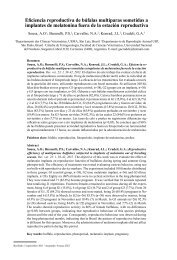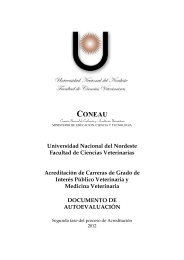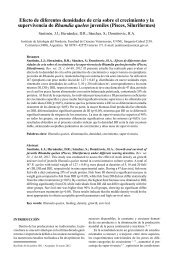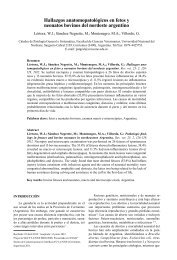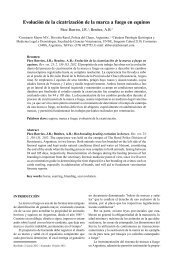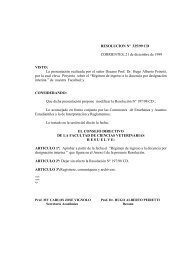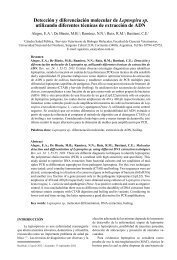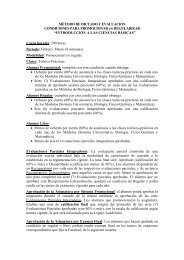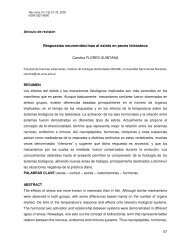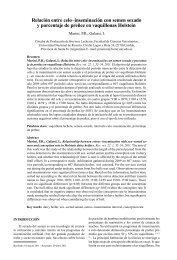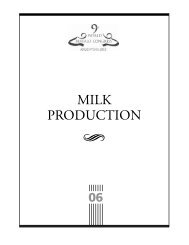REPRODUCTION - Facultad de Ciencias Veterinarias
REPRODUCTION - Facultad de Ciencias Veterinarias
REPRODUCTION - Facultad de Ciencias Veterinarias
Create successful ePaper yourself
Turn your PDF publications into a flip-book with our unique Google optimized e-Paper software.
828<br />
<strong>REPRODUCTION</strong><br />
spectrophotometer (MS2 Rea<strong>de</strong>r) at a wavelength of 550 nm. A small drop of the semen sample after the measurement of<br />
second optical <strong>de</strong>nsity (OD) was observed un<strong>de</strong>r the microscope (X 1000) for the viable cells that <strong>de</strong>veloped colored<br />
formazan following reduction by the MTT assay. MTT reduction rate (optical <strong>de</strong>nsity) for each sample was calculated by<br />
concurring the difference between the first and second reading of the spectrophotometer.<br />
Statistic Analysis<br />
Statistical program SPSS for window (version 10.0.1, SPSS Inc., Chicago, Illinois, USA) was used for data analysis. The<br />
Kolmogorov Smirnov test was used to test the normal distribution of the data. Results are expressed as Means ± S.E.<br />
Pearson correlation coefficients and Regression analysis was used to evaluate the efficacy of the MTT assay for the<br />
assessment of sperm viability of the buffalo semen. An in<strong>de</strong>pen<strong>de</strong>nt Stu<strong>de</strong>nt’s t test was used to compare the means<br />
between two groups for each parameter. A probability value at P < 0.05 was consi<strong>de</strong>red to be significant.<br />
RESULTS<br />
The mean volume of semen collected was more (P < 0.05) in group A (7.12 ± 0.5) compared to bulls of group B (5.29 ±<br />
0.6). However, the concentration of spermatozoa (562.5 ± 31.6 vs. 642.2 ± 66.4 millions/ml) and testes circumference<br />
of the bulls (34.7 ± 0.14 vs. 34.47 ± 0.2 cm) were similar (P > 0.05) in both groups. There was no significant difference<br />
between two groups for the remaining spermatozoal variables recor<strong>de</strong>d. Data were, therefore, pooled for both groups (n<br />
= 20) for subsequent analyses. The means of percentages of live spermatozoa for MTT, E-N, HOST and motility were 74.7<br />
± 1.9, 68.8 ± 0.7, 59.5 ± 1.0 and 72.3 ± 0.5 respectively. After incubation of the semen samples for an hour, a regression<br />
equation of the relationship between the MTT reduction rate and the percentage of viable spermatozoa was calculated (y<br />
= 90.403x -0.109). The corresponding curve is presented in Figure 1 and this was later used to <strong>de</strong>termine the viability<br />
of the spermatozoa based on the other diagnostic tests. The OD was significantly (P < 0.001) correlated (r = 0.995) with<br />
the percentage of viable spermatozoa. Results also showed a very low negative correlations (P > 0.05) between the results<br />
of the MTT reduction rate and the percentage of viable spermatozoa as <strong>de</strong>termined by either eosin or nigrosin staining<br />
(r = -0.32, Figure 2), HOST (r = -0.12; Figure 3) or percentage spermatozoal motility (r = -0.08; Figure 4). The distribution<br />
of the experimental breeding bulls based on the various percentages of viable spermatozoa as <strong>de</strong>termined by<br />
different diagnostic tests is set out in Table 1. Most of the animals exhibited the presence of viable spermatozoa were<br />
between a range of 60-80% in all the conducted tests. However, MTT was able to <strong>de</strong>termine the >90% viable spermatozoa<br />
in two bulls (Table 1).<br />
Figure 1 Relationship between MTT reduction rate and<br />
percentage of viable spermatozoa. The regression curve<br />
shown is y = -0.109+90.402x; r =0.995; n = 20; OD =<br />
optical <strong>de</strong>nsity<br />
Figure 2 Relationship between MTT reduction rate and<br />
percentage of viable spermatozoa (eosin and nigrosin<br />
staining). The regression curve shown is y = 77.15-<br />
10.15x; r =- 0.32; n = 20; OD = optical <strong>de</strong>nsity<br />
Proceedings 9 th World Buffalo Congress



